Discover The Mixed Architectural Structure Of Rumi Darwaza In 2026
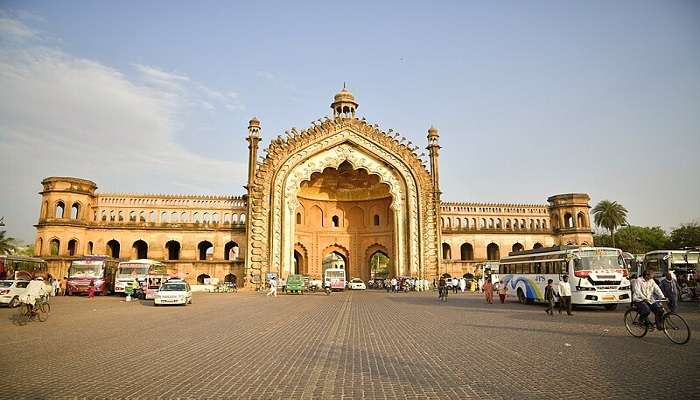
The mammoth 18m tall Rumi Darwaza, built by Nawab Asaf-ud-Daula in 1784, served as the grand entrance to the majestic city of Lucknow. It is also known as the Turkish Gateway for it was erroneously thought to be identical to the gateway at Constantinople. The monument provides the main entrance to the Great Imambara and is embellished with opulent decorations. This imposing gateway stands between the two neighbouring imambaras of the city. Made of red sandstone and marble, the construction of Rumi Darwaza and Bara Imambara was the Nawab’s way of generating employment during the famine of the 1780s.
History Of Rumi Darwaza
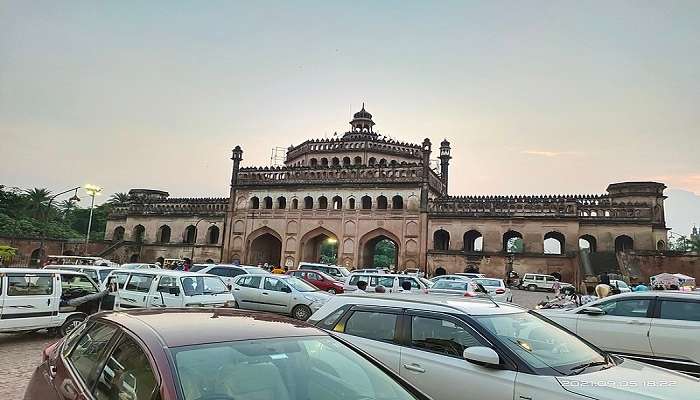
Mirza Asaf-ud-Daula was the Nawab wazir of Oudh (or Awadh), from 26 January 1775 to 21 September 1797. Asaf-ud-Dowlah became Nawab at the age of 26, on the death of his father, Shuja-ud-Daula, in 1775. He assumed the throne with the aid of the British East India Company, outmanoeuvring his younger brother Saadat Ali who led a failed mutiny in the army. In 1775 he decided to move the capital of Awadh from Faizabad to Lucknow and then, he built various monuments in and around Lucknow that still attract tourists to Lucknow.
Nawab Asaf-ud-Dowlah is widely considered the architect general of Lucknow. His contribution to the city in terms of the grand yet beautiful structures standing in the city is invaluable. With the sole intention to outshine the splendour and grandeur of Mughal architecture, he built several monuments and developed the city of Lucknow into an architectural marvel. Several of the buildings surviving today, including the famed Asafi (or Bara) Imambara, Chota Imambara, Rumi Darwaza and the Qaisar Bagh area of downtown Lucknow, attract many tourists even today.
Must Read: Things To Do In Lucknow
Why Was Rumi Darwaza Built?

The Asafi Imambara and the Rumi Darwaza are famed structures surrounded by beautiful gardens, which the Nawab started as a charitable project to generate employment during the famine of 1784. In that dreadful famine, even the nobles, immune to such situations owing to their generational wealth and status, were reduced to poverty and sought employment. Nawab Asaf is said to have employed more than 20,000 people for this project (including the commoners and even the noblemen). Another remarkable fact is that this structure was constructed to build neither a masjid nor a mausoleum (contrary to the popular contemporary norms of buildings at that time).
During the daytime, everyday citizens employed on the project would work to construct the structures of the building. On the night of every fourth day, the noble and upper-class people were employed secretly to demolish the structure built, an effort for which they received payment. Thus, their dignity was preserved. The Nawab’s sensitivity towards maintaining the reputation of the upper class is also very clearly demonstrated in the story of the construction of Imambara. Today, this project is studied and considered to precede a Keynesian-like intervention for employment generation. Construction of the Imambara was completed in 1784. The estimated cost of building the Imambara ranges from half a million to a million rupees. Even after completion, the Nawab used to spend between four and five hundred thousand rupees on its decoration annually. The gate, which stands imposingly between Bara Imambara and the Chota Imambara, Rumi Darwaza, and the surrounding complex, is generally very busy all day and bustles with tourists on weekends. The streets have now been redeveloped into a style similar to their earlier construction of hard brick roadways. Over the years, the place has become one of the most popular spots in the city.
Why Is Rumi Darwaza Called So?

The design of the gate was inspired, and the construction of this gate was even modeled after a historical gate in Constantinople. Rumi refers to Rûm, the name used by the Islamic world historically to denote the region roughly corresponding to Anatolia or the dominion of the erstwhile Eastern Roman Empire. Hence, Rumi Darwaza in Hindustani (a mixture of several languages spoken in the Awadh area around the time of construction) translates to Turkish Gate in English. The Darwaza is distinct from Mughal architecture in style and materials used. The design consists of a big arch and on top of that, there is a half-spherical dome resting on a half-octagonal plan. Instead of traditional building materials used by the Mughals, this gate is built using thin burnt clay bricks as well as lime-crushed brick aggregate mortar, also called Lakhori and Surkhi, respectively (as they were prevalent during the rule of Nawabs in the 18th century). The gate proudly boasts a wide variety of intricate carvings of flowers.
The design, which resembles Mughal, Roman, and Turkish styles, amalgamated the prominent and distinct designs of the three and became famous as Awadhi or Lakhnawi architecture. Hence, Nawab Asa-ud-Daula can be duly credited with the development of a new school of architecture. Rumi Darwaza, as a structure, distinctly strays away from red sandstone, which had become a prominent telling feature of Mughal architecture.
Suggested Read: Places To Visit In Lucknow
Nearby Tourist Attractions
Chota Imambara, Bara Imambara, Clock Tower, Art Gallery etc are located within a distance of just 2 km. If you choose to walk from one imambara to the other, you would be able to explore all these other attractions as well.
1. Bara Imambara
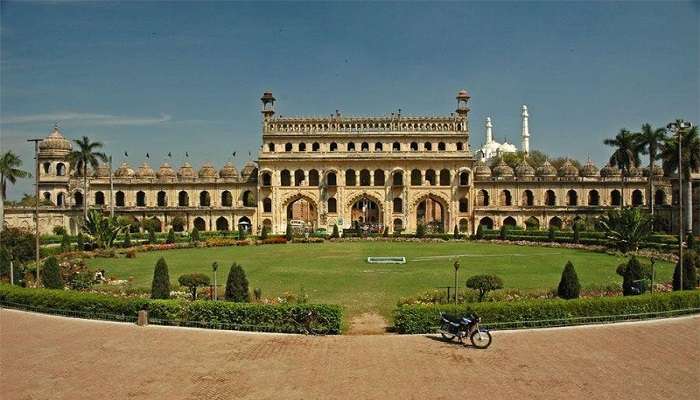
Bara Imambara, also known as Asafi Imambara locally, is an imambara complex in Lucknow, Uttar Pradesh, built by Asaf-ud-Daula, Nawab of Awadh, in 1784. Bara (in Hindi) translates to big. An Imambara, in general, is a shrine built by Shia Muslims for the purpose of Azadari. The Bara Imambara is not only a significant religious site for Muslims, but it is also a testament of the syncretic Awadhi culture and architectural innovation of the time. Today, it proudly stands as one of the most famous monuments in the City of Nawabs.
This Imambara is prominently known for its incredible maze, locally known as the Bhul Bhulaiya, which has as many as 1024 ways to get inside but only 2 to come out. Simultaneously, it also reflects the Nawabi era’s opulence and their immense and invaluable contribution to arts, culture, and architecture, despite the political turmoils of the period.
2.Chota Imambara
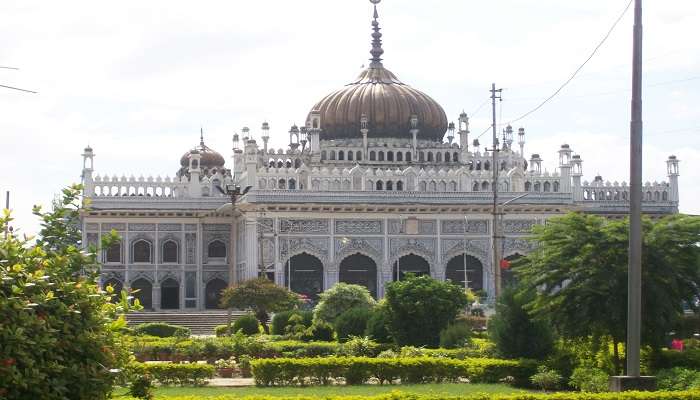
Chota Imambara, also known as Imambara Hussainabad Mubarak locally, is a monument located in the city of Lucknow, Uttar Pradesh, India. It took a shocking 54 years to build. Primarily built as an imambara or a congregation hall for Shia Muslims, by Muhammad Ali Shah, the Nawab of Awadh in 1838, but additionally, it continues to serve as a mausoleum for the Nawab and his mother.
The Chhota Imambara stands to the west of Bara Imambara and the two are separated by the grand structure of a gateway known as Rumi Darwaza. Recently, in 2016, the building was renovated but both the process and the results have been severely criticised.
Suggested Read: Romantic Restaurants In Lucknow
Admission Into Rumi Darwaza
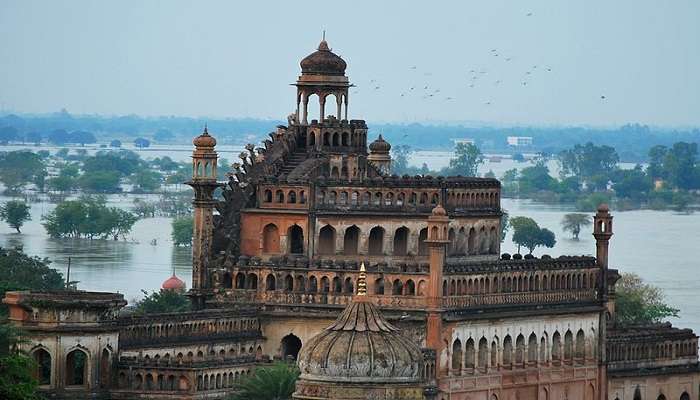
Although the surrounding monuments like Bara and Chota Imambara are accessible to visitors only after the payment of a nominal fee, the ticket price for Indian tourists is Rs 50 for adults and Rs 25 for children, and for foreign tourists, it is Rs 500.
However, Rumi Darwaza offers general admission to the public. This means that visitors do not have to pay a ticket price to explore and bask in the wonder of its exquisite architecture and intricate designs.
Further Read: Places To Visit in Uttar Pradesh
Now you have complete information about Rumi Darwaza and the surrounding monuments that give you a list of reasons to visit Lucknow. Make sure you plan your trip to Uttar Pradesh at the earliest and don’t forget to explore all the architectural marvels of this city. Don’t miss out on exploring these wonders and book your tickets now!
For our editorial codes of conduct and copyright disclaimer, please click here.
Cover Image Credit: Rishabhgpt for wikimedia commons
Frequently Asked Questions About Rumi Darwaza
What does the word Rumi Darwaza mean?
Rumi refers to Rûm, the name used by the Islamic world, historically, to denote the region roughly corresponding to Anatolia or the dominion of the erstwhile Eastern Roman Empire. Hence, Rumi Darwaza in Hindustani (a mixture of several languages spoken in the Awadh area around the time of construction) translates to Turkish Gate in English.
How was Rumi Darwaza built?
During the daytime, common citizens employed on the project would work to construct the structures of the building. While, on the night of every fourth day, the noble and upper-class people were employed in secret to demolish the structure built, an effort for which they received payment.
Why do so many tourists visit Bara Imambara?
The Bara Imambara is primarily known for its incredible maze, known as Bhul Bhulaiya locally. Located on the upper floor of the monument. It is said that there are as many as 1024 ways to get inside the maze but only 2 to come out.
What are the other examples of mixed architectural styles in India?
How did the city of Lucknow get its name?
According to one legend, the city is named after Lakshmana, a hero of the Hindu epic Ramayana. The legend states that Prince Lakshmana had a palace in this area, which was known as Lakshmanapuri. Over time, particularly by the 11th century, the settlement came to be known as Lakhanpur (or Lachhmanpur) and later, as we know the city now - Lucknow.
People Also Read:
Hotels In Hazratganj Lucknow Places To Visit In Lucknow Hill Stations Near Lucknow

With a passion for exploring and travelling to the roads long forgotten, experience the world through enthralling stories and adventures. Join me as I share my experiences at some of the world’s most popular tourist destinations and quench that pestering curiosity with something exciting!











